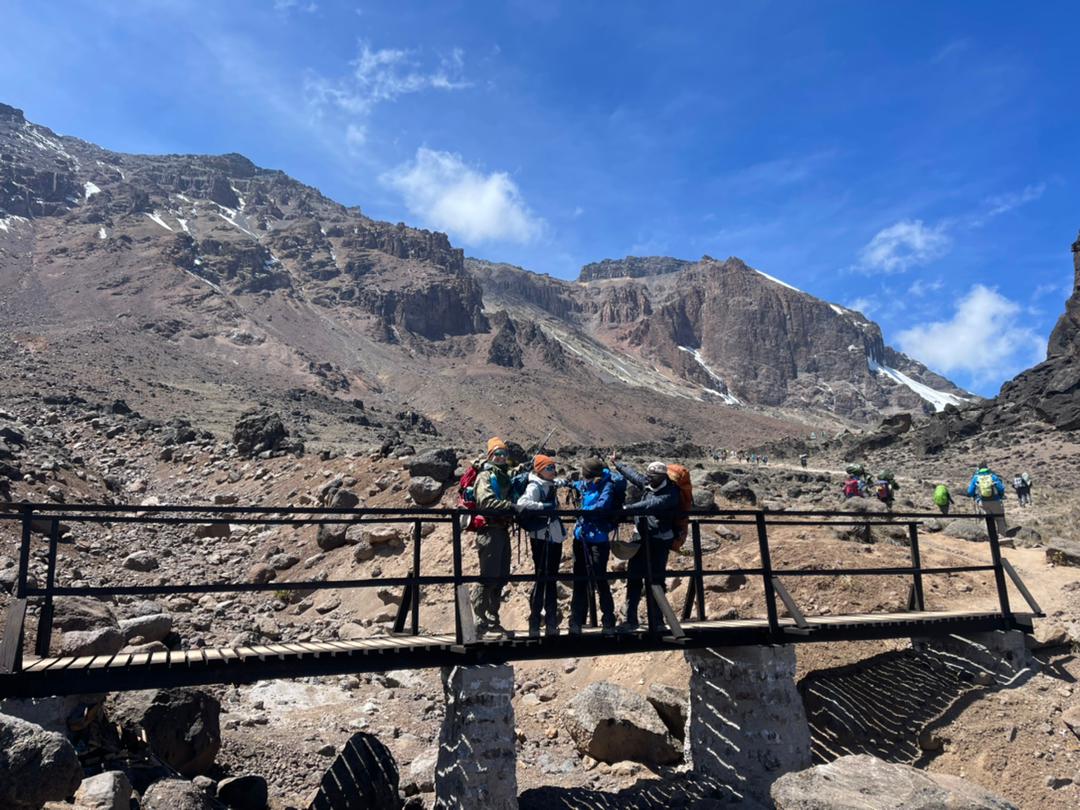CLIMBING KILIMANJARO GUIDES AND PORTERS
At the very heart of our business and fundamental to your safety and enjoyment, are the mountain guides we employ. All of our Kilimanjaro guides are hand-picked by us to ensure you get the very best leadership on the mountain.
Our guides Licensed by the National Park and are certified Wilderness First Responders (WFR)
Our guides conduct health checks twice daily using pulse oximeters to measure pulse and oxygen saturation
We carry emergency oxygen, a portable stretcher and a medical kit on all our Mt Kilimanjaro climbs
We have established protocols for handling emergencies on the mountain, including rescue and evacuation.
The importance of your Kilimanjaro crew cannot be underestimated: they make the difference between a wonderful experience on Kilimanjaro and an absolutely disastrous one.
Each of our guides is licensed by Kilimanjaro National Park and climb Kilimanjaro frequently each year. They all speak fluent English as well as Chagga and Kswahilli. We do not subcontract any of our operations. All our climbs are supported by a crew of local people who are experts on the mountain.
Each kilimanjaro guide has his own team of assistant guides and camp staff who work together on every climb. This collaboration gives a team dynamic that translates into an unparalleled level of service on the mountain. On all Kilimanjaro climbs we keep a ratio of three clients to one guide so every climber receives personal attention and encouragement.
We comply with Kilimanjaro Porters Assistance Project (KPAP) guidelines to ensure our team of porters have the appropriate equipment, that they are paid fairly, given adequate food and accommodation and that their loads are not excessive.
Our guides have received first aid training from Kilimanjaro National Park prior to their certification and get additional training from us on a regular basis. They can recognize the symptoms of serious altitude sickness and organize an immediate descent which is by far the best treatment. We follow an established protocol for handling emergencies on the mountain, including rescue and evacuation procedures.
For a trek for two people over 7 days a normal crew would comprise 1 x lead guide, 1 x assistant guide, 1 x cook and 6 porters. We will inform you of the size of your crew before you depart.
WHAT DO YOU EAT ON KILIMANJARO CLIMB?
Our chefs will serve large, healthy meals to keep you happy and well-fed on your Kilimanjaro climb. You’ll have hot meals at breakfast and dinner, freshly prepared with locally-sourced ingredients. We prepare all our food to strict hygiene standards, ensuring it’s delicious and safe to eat. Our menus are designed to be nutritionally-dense, with plenty of variety to cater to the energy demands of the trek.
Daily Kilimanjaro Sample Menus
We have a dining tent with chairs and for just dinning. Whilst each day you will be served different meals whilst on the Kilimanjaro climb, below is a guideline to what type of food you can expect :
Breakfast is usually porridge followed by sausage and eggs, toast and marmalade or jams and hot drinks such as tea, coffee or chocolate. Climbers are asked to communicate with the guide as regards their appetites or we will tend to err on the side of caution in providing much more food than necessary.
Lunch is usually a packed lunch that you will carry in your daypack. It normally consists of a boiled egg, some sandwiches, a chicken portion, fresh fruit and a cold drink. At the end of the day’s walking, afternoon tea is served with biscuits, peanuts and, best of all, salted popcorn and plenty of hot drinks.
Dinner begins with soup, followed by a main course including chicken or meat, a vegetable sauce, some cabbage, and rice, pasta or potatoes, with fresh fruit for dessert .
Even though you are far from home we recognise that it’s nice to have some creature comforts, so don’t be surprised when you see some of your favorite food brands, such as Heinz, Nescafe and Nestle!
We can accommodate all dietary restrictions, just let us know in advance. In the case of very strict diets, we recommend you bring along some of your favorite “energy” foods, as some specialty ingredients can be hard to source in Tanzania.
One very common effect of the altitude is a reduced appetite. We offer enticing meals, rich in “good” carbohydrates. According to the US Army Research Institute of Environmental Medicine, “carbohydrate is the most efficient fuel for optimizing performance at altitude”, speeding up recovery and replenishing muscle glycogen stores for the next day’s activity.
The same study goes on to say, “a high carbohydrate diet at altitude is recommended as an intervention to alleviate symptoms of AMS (acute mountain sickness)” as it increases ventilation and blood oxygenation.
With the decreased appetite, carbohydrate-based foods are often more palatable than high protein or fats, and altitude changes your metabolic processes. The combination of hours on the trail and your body’s adaptation to altitude means you’ll have a much higher energy requirement than you would have at home.
Experienced hikers who are used to eating horrible dehydrated foods on the trail are often surprised at the quality and variety of food that comes out of our mountain kitchens. We use only fresh produce, no dehydrated “ready meals” and all food is carried up Mount Kilimanjaro by our porters.

